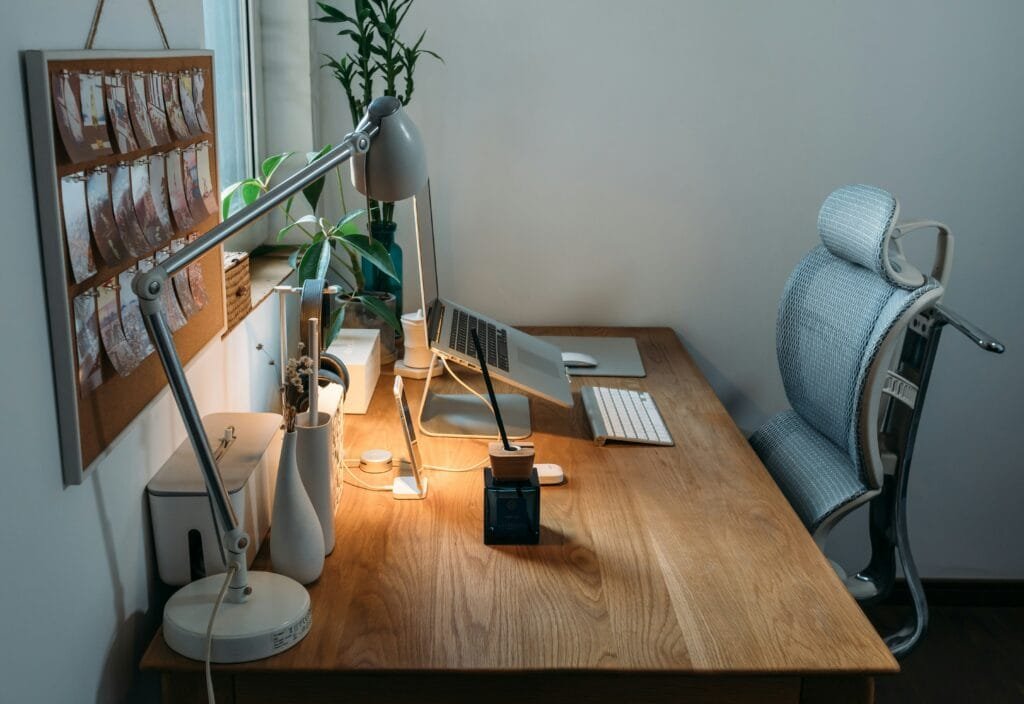Many people spend hours at a desk, staring at a screen. By the end of the day, their back aches, shoulders feel stiff, and headaches start creeping in. Sound familiar?
One of my patients recently came in with lower back pain. He was convinced an old injury had flared up again. But as we talked, something else became clear—he had switched to a standing desk and was now standing for hours without moving much. Instead of shifting positions regularly, he would rock from side to side and lean onto his left hip—exactly where his pain was.
Office work may seem low-risk, but prolonged static postures—whether sitting or standing—can take a serious toll on the body. Research shows that office workers spend an average of 6.29 hours of an 8-hour workday sitting (Daneshmandi et al., 2017). This lack of movement can lead to neck pain, lower back discomfort, and tight shoulders—all common complaints among desk-based workers.
But here’s the good news: small adjustments can make a big difference. The key isn’t just about sitting up straight—it’s about keeping your body moving throughout the day.
In this blog, we'll cover:
Why Office Workers Experience Pain & Discomfort
It’s easy to assume that sitting at a desk is harmless. After all, you’re not lifting heavy objects or doing anything physically demanding. But many office workers develop persistent aches and pains simply from staying in one position for too long.
The Most Common Complaints
A research showed that office workers often reported neck pain, lower back pain, and shoulder pain the most (Daneshmandi et al., 2017). These problems don’t appear overnight—they build up over time as a result of poor movement habits and bad desk setups.
I see this in my clinic all the time. Many patients come in with upper back tightness, lower back aches, and even headaches—all linked to the way they work at their desks. Some think it’s just stress or an old injury flaring up, but the reality is that their work posture is creating strain on their muscles and joints.
The Real Issue: Lack of Movement
The biggest mistake people make? They don’t move enough.
Whether they’re sitting or standing, many office workers stay in one posture for hours. Some assume that getting up to grab a drink once every hour is enough—but it isn’t.
📌 Here’s what happens when you stay in one position too long:

- Your spine, ligaments, and tendons start to stretch under pressure.
- Your muscles tighten as they hold the same posture for extended periods.
- Pressure builds in the lower back and upper back, leading to pain and discomfort.
Even standing desks aren’t a magic fix. If you’re standing still for too long, you can create just as much strain as sitting. Like my patient who leaned on one hip all day, small repetitive movements can add up over time, leading to imbalances and pain.
The key isn’t just having a “perfect” posture—it’s about moving regularly throughout the day.
The Role of Posture & Movement in Preventing Pain
Many people believe that if they just sit up straight, they’ll avoid back pain. But posture alone isn’t the issue—staying in one posture for too long is.
One of the biggest mistakes office workers make is not moving enough throughout the day. Some think that shifting from side to side or standing up once an hour is enough. But research suggests that even with sit-stand desks, discomfort is reduced when movement is frequent rather than simply alternating between sitting and standing (Karakolis, 2014).
📌 Why Movement Matters More Than Posture:
- Sitting for more than 20 minutes puts strain on the spine, ligaments, and muscles.
- Holding the same position for too long tightens muscles and reduces flexibility.
- Standing still for long periods can also cause imbalances, especially if you lean on one side.
- A sit-stand desk is only beneficial when used correctly—too much standing without movement can be just as harmful as prolonged sitting.

A study found that when workers were given sit-stand desks with minimal guidance, they naturally adopted a 15-minute sitting to 5-minute standing ratio (Alkhajah et al., 2012). This suggests that alternating positions frequently can help prevent discomfort and reduce lower back strain.
The Best Posture is the One That Moves
If you want a simple rule, aim to move once every 20 minutes (as seen above, everyone is different).
- Not only shift in your chair—stand, stretch, or walk.
- If using a sit-stand desk, change positions regularly rather than standing still for hours.
- Listen to your body. If something feels stiff or tight, it’s time to move.
By building these small habits into your workday, you can reduce strain on your spine and prevent desk-related aches.
Simple Stretches & Desk Adjustments to Reduce Pain
Making small changes to your desk setup and incorporating stretches into your day can make a big difference in how your body feels. The goal isn’t to create a perfect workstation but to reduce strain and encourage movement.
Stretching: Releasing Tension from Desk Work
One of the biggest issues I see in office workers is tightness in the chest and shoulders. Sitting at a desk often shortens the chest muscles and overstretches the upper back, leading to discomfort.
📌 Try these simple stretches:

- Chest stretch: Stand in a doorway, place your hands on the frame, and step forward to stretch your chest.
- Neck mobility: Gently tuck your chin in and hold for a few seconds to relieve tension at the base of the skull.
- Shoulder rolls: Lift your shoulders toward your ears, then roll them back and down to release built-up tension.
Optimising Your Desk Setup
📌 Your desk should support your posture, not force you into uncomfortable positions. Here’s what I recommend:
- Screen height: Your monitor should be at eye level so you're not constantly looking down.
- Laptop users: Use a laptop riser so that the top of the screen is at eye level. Pair it with a separate keyboard and mouse, positioning them at belly-button level to keep your arms and shoulders relaxed.
- Chair position: Your feet should rest flat on the floor, and your knees should be at a 90-degree angle.
- Keyboard and mouse: Keep them close enough that your elbows remain at a comfortable angle.

A Balanced Work Routine
Even with the best setup, staying in one position too long will still lead to discomfort.
- Stretch or move every 20 minutes to prevent stiffness.
- Switch between sitting and standing if you have a sit-stand desk—but avoid standing still for long periods.
- Listen to your body. If something feels tight or sore, make an adjustment.
By combining good desk habits with regular movement, you can reduce the strain of desk work and keep your body feeling its best.
When to See a Chiropractor
Sometimes, making adjustments to your workstation and moving more throughout the day is enough to prevent discomfort. But if you’re still experiencing persistent pain or stiffness, it might be time to seek professional help.
Signs It’s Time to See a Chiropractor
If you’re experiencing any of the following, a chiropractor may be able to help:
- You constantly feel hunched over, no matter how much you try to sit up straight.
- You get headaches while working that seem to start at the back of your head or neck.
- You struggle to concentrate because you’re always thinking about the dull ache in your back.
- You feel tightness or discomfort between your shoulder blades that doesn’t go away with stretching.
- You feel that your lower back pain persists even after making changes.

If these symptoms sound familiar, it’s worth getting checked. A chiropractor can assess how your body is moving, identify areas of tension or imbalance, and help you improve mobility.
What to Expect from Chiropractic Care
Many of my patients report feeling more mobile and comfortable after treatment. When movement improves, sitting at a desk feels easier because there’s less tension in the spine, neck, and shoulders.
Along with treatment, a chiropractor can provide specific exercises and advice to help you maintain good posture and prevent discomfort in the long run.
The key takeaway? If your pain is interfering with your focus, productivity, or daily life, don’t ignore it. Getting the right help early on can stop small issues from turning into long-term problems.
Conclusion: Small Changes, Big Impact
Spending long hours at a desk doesn’t have to mean dealing with constant aches and pains. The key isn’t about finding the perfect posture—it’s about moving more and making small adjustments to support your body.
Aim to change positions every 20 minutes and set up your workspace in a way that supports good posture. Adjust your screen height, use a separate keyboard and mouse if needed, and stretch regularly to prevent tension from building up.
Most importantly, listen to your body. If discomfort persists despite making changes, it may be time to see a chiropractor. Getting the right help early on can stop small aches from becoming long-term problems.



2 responses to “Chiropractic Care for Office Workers: How to Prevent and Manage Desk-Related Aches”
[…] This is why movement quality matters. If you continue making “withdrawals” from your body’s movement reserves without “depositing” good habits like proper mechanics and recovery, you’ll eventually pay the price. The good news? You can regain control. The habits of desk workers often match 2. or 3. If you feel like that’s you, check out my last blog: Chiropractic Care for Office Workers: How to Prevent and Manage Desk-Related Aches […]
[…] and mobility will set you up for long-term success. If you work at your desk a lot – click here to check out one of my last blogs on how to prevent desk-related […]